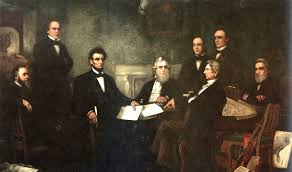
The Emancipation Proclamation Enacted By President Abraham Lincoln
Cross note: Sections 1, 5, 9, deployment of US military either by President or specially appointed envoys, and aforementioned law enforcement officials
A Proclamation” Background:
Almost from the beginning of his administration, Lincoln was pressured by abolitionists and radical Republicans to issue an Emancipation Proclamation. In principle, Lincoln approved, but he postponed action against slavery until he believed he had wider support from the American Public.
The passage of the Second Confiscation Act by Congress on July 17, 1862, which freed the slaves of everyone in rebellion against the government, provided the desired signal. Not only had Congress relieved the Administration of considerable strain with its limited initiative on emancipation, it demonstrated an increasing public abhorrence toward slavery.
Lincoln had already drafted what he termed his “Preliminary Proclamation.” He read his initial draft of the Emancipation Proclamation to Secretaries William H. Seward and Gideon Welles on July 13, 1862.
For a moment, both Secretaries were speechless. Quickly collecting his thoughts, Seward said something about anarchy in the South and possible foreign intervention, but with Welles apparently too confused to respond, Lincoln let the matter drop.
Nine days later, on July 22, Lincoln raised the issue in a regularly scheduled Cabinet meeting. The reaction was mixed. Secretary of War Edwin M. Stanton, correctly interpreting the Proclamation as a military measure designed both to deprive the Confederacy of slave labor and bring additional men into the Union Army, advocated its immediate release.
Treasury Secretary Salmon P. Chase was equally supportive, but Montgomery Blair, the Postmaster General, foresaw defeat in the fall elections.
Attorney General Edward Bates, a conservative, opposed civil and political equality for Blacks but gave his qualified support. Fortunately, President Lincoln only wanted the advice of his Cabinet on the style of the Proclamation, not its substance. The course was set.
The Cabinet meeting of September 22, 1862, resulted in the political and literary refinement of the July draft, and on January 1, 1863, Lincoln composed the final Emancipation Proclamation. It was the crowning achievement of his administration.
The original autograph was lost in the Chicago fire of 1871. Surviving photographs of the document show it primarily in Lincoln’s own hand. The superscription and ending are in the hand of a clerk, and the printed insertions are from the September draft.
Preliminary Emancipation Proclamation, 1862
“. . . on the first day of January . . . all persons held as slaves within any State, or designated part of a State, the people whereof shall then be in rebellion against the United States shall be then, thenceforward, and forever free.” President Abraham Lincoln, preliminary Emancipation Proclamation, September 22, 1862
President Lincoln issued the preliminary Emancipation Proclamation in the midst of the Civil War, announcing on September 22, 1862, that if the rebels did not end the fighting and rejoin the Union by January 1, 1863, all slaves in the rebellious states would be free.

I’m not that much of a internet reader to be honest but your sites really nice, keep it up! I’ll go ahead and bookmark your website to come back later. All the best|
My programmer is trying to persuade me to move to .net from PHP. I have always disliked the idea because of the expenses. But he’s tryiong none the less. I’ve been using Movable-type on a number of websites for about a year and am concerned about switching to another platform. I have heard excellent things about blogengine.net. Is there a way I can transfer all my wordpress posts into it? Any help would be greatly appreciated!|